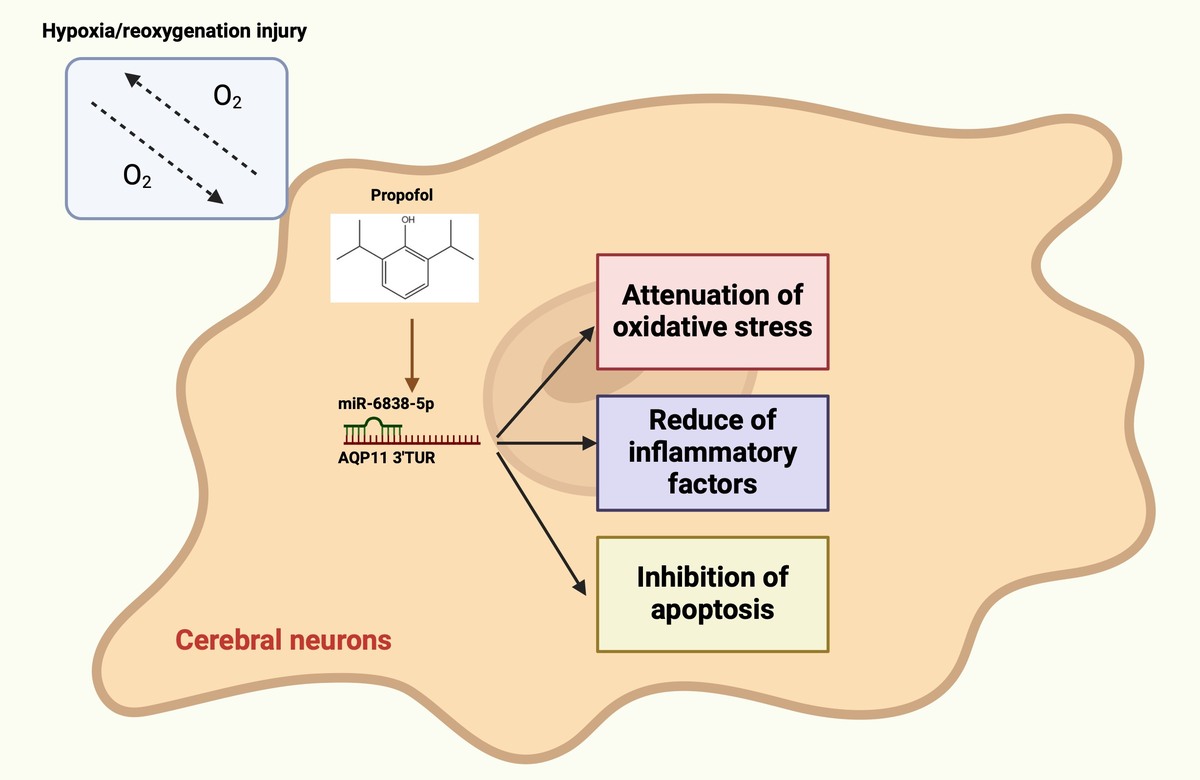Current issue
Archive
Manuscripts accepted
About the Journal
Editorial office
Editorial board
Section Editors
Abstracting and indexing
Subscription
Contact
Ethical standards and procedures
Most read articles
Instructions for authors
Article Processing Charge (APC)
Regulations of paying article processing charge (APC)
NEUROLOGY / RESEARCH PAPER
Propofol improves neuronal apoptosis and oxidative damage mediated by cerebral ischemia-reperfusion by regulating the miR-6838-5p/AQP11 axis
1
Department of Anesthesiology, Shandong Cancer Hospital and Institute, Shandong First Medical University and Shandong Academy of Medical Sciences, China
2
Department of Anesthesiology, The 960th Hospital of the PLA, China
Submission date: 2024-11-21
Final revision date: 2025-01-23
Acceptance date: 2025-02-10
Online publication date: 2025-04-20
Corresponding author
XiuQin Wang
Department of Anesthesiology, Shandong Cancer Hospital and Institute, Shandong First Medical University and Shandong Academy of Medical Sciences, 250117, Jinan City, China
Department of Anesthesiology, Shandong Cancer Hospital and Institute, Shandong First Medical University and Shandong Academy of Medical Sciences, 250117, Jinan City, China
KEYWORDS
TOPICS
ABSTRACT
Introduction:
This study aimed to elucidate the mechanism by which Propofol (PPF) exerts its effects in cerebral ischemia-reperfusion injury (CI/RI).
Material and methods:
A rat model of CI/RI was established via middle cerebral artery occlusion/reperfusion (MCAO/R). MCAO/R rats were pre-treated with PPF (10 mg/kg) via intraperitoneal injection. Additionally, 48 hours before PPF administration, miR-6838-5p agomir/antagomir and aquaporin-11 (AQP11) lentiviral overexpression vectors were injected into MCAO/R rats. Infarct size was determined using 2,3,5-triphenyl tetrazolium chloride staining. Neurological function was assessed using standardized scoring, and cerebral edema was measured by determining brain water content. Hematoxylin-eosin staining, Nissl staining, and Terminal deoxynucleotidyl transferase dUTP nick end labeling staining were performed on brain tissues. Inflammatory and oxidative markers were evaluated. A hypoxia/reoxygenation (H/R) injury model was established in PC12 cells to assess miR-6838-5p and AQP11 expression levels, as well as cell viability and apoptosis.
Results:
The lethal dose 50 (LD₅₀) of PPF in rats was determined to be 22.6 mg/kg, significantly higher than the therapeutic dose. PPF or overexpression of miR-6838-5p resulted in reduced cerebral infarct size, neuronal necrosis, and apoptosis, increased Nissl bodies, and decreased brain edema, apoptosis, tumor necrosis factor-α, interleukin-1β, and malondialdehyde (MDA) levels. Glutathione peroxidase (GSH-Px) and superoxide dismutase (SOD) activities were elevated in MCAO/R rats treated with PPF. These protective effects of PPF were reversed by miR-6838-5p knockdown or AQP11 overexpression. PPF ameliorated H/R-induced neuronal damage, enhanced neuronal activity, reduced apoptosis and MDA production, and increased GSH-Px and SOD levels.
Conclusions:
PPF ameliorates CI/RI by modulating the miR-6838-5p/AQP11 axis.
This study aimed to elucidate the mechanism by which Propofol (PPF) exerts its effects in cerebral ischemia-reperfusion injury (CI/RI).
Material and methods:
A rat model of CI/RI was established via middle cerebral artery occlusion/reperfusion (MCAO/R). MCAO/R rats were pre-treated with PPF (10 mg/kg) via intraperitoneal injection. Additionally, 48 hours before PPF administration, miR-6838-5p agomir/antagomir and aquaporin-11 (AQP11) lentiviral overexpression vectors were injected into MCAO/R rats. Infarct size was determined using 2,3,5-triphenyl tetrazolium chloride staining. Neurological function was assessed using standardized scoring, and cerebral edema was measured by determining brain water content. Hematoxylin-eosin staining, Nissl staining, and Terminal deoxynucleotidyl transferase dUTP nick end labeling staining were performed on brain tissues. Inflammatory and oxidative markers were evaluated. A hypoxia/reoxygenation (H/R) injury model was established in PC12 cells to assess miR-6838-5p and AQP11 expression levels, as well as cell viability and apoptosis.
Results:
The lethal dose 50 (LD₅₀) of PPF in rats was determined to be 22.6 mg/kg, significantly higher than the therapeutic dose. PPF or overexpression of miR-6838-5p resulted in reduced cerebral infarct size, neuronal necrosis, and apoptosis, increased Nissl bodies, and decreased brain edema, apoptosis, tumor necrosis factor-α, interleukin-1β, and malondialdehyde (MDA) levels. Glutathione peroxidase (GSH-Px) and superoxide dismutase (SOD) activities were elevated in MCAO/R rats treated with PPF. These protective effects of PPF were reversed by miR-6838-5p knockdown or AQP11 overexpression. PPF ameliorated H/R-induced neuronal damage, enhanced neuronal activity, reduced apoptosis and MDA production, and increased GSH-Px and SOD levels.
Conclusions:
PPF ameliorates CI/RI by modulating the miR-6838-5p/AQP11 axis.
Share
RELATED ARTICLE
We process personal data collected when visiting the website. The function of obtaining information about users and their behavior is carried out by voluntarily entered information in forms and saving cookies in end devices. Data, including cookies, are used to provide services, improve the user experience and to analyze the traffic in accordance with the Privacy policy. Data are also collected and processed by Google Analytics tool (more).
You can change cookies settings in your browser. Restricted use of cookies in the browser configuration may affect some functionalities of the website.
You can change cookies settings in your browser. Restricted use of cookies in the browser configuration may affect some functionalities of the website.



